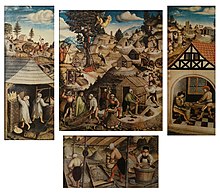
Uraninite, also known as pitchblende, is a radioactive, uranium-rich mineral and ore with a chemical composition that is largely UO2 but because of oxidation typically contains variable proportions of U3O8. Radioactive decay of the uranium causes the mineral to contain oxides of lead and trace amounts of helium. It may also contain thorium and rare-earth elements.

Zwickau is the fourth-largest city of Saxony, Germany, after Leipzig, Dresden and Chemnitz, with around 88,000 inhabitants,.
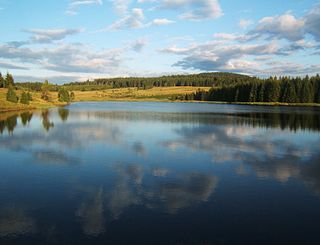
The Ore Mountains lie along the Czech–German border, separating the historical regions of Bohemia in the Czech Republic and Saxony in Germany. The highest peaks are the Klínovec in the Czech Republic at 1,244 metres (4,081 ft) above sea level and the Fichtelberg in Germany at 1,215 metres (3,986 ft).

Jáchymov is a spa town in Karlovy Vary District in the Karlovy Vary Region of the Czech Republic. It has about 2,400 inhabitants.

Annaberg-Buchholz is a town in Saxony, in eastern Germany. Lying in the Ore Mountains, it is the capital of the district of Erzgebirgskreis.

Abertamy is a town in Karlovy Vary District in the Karlovy Vary Region of the Czech Republic. It has about 800 inhabitants. It is known as a winter sports centre. The town is historically associated with silver and tin mining and is located in the Ore Mountain Mining Region, which is a UNESCO World Heritage Site.

Marienberg is a town in Germany. It was the district capital of the Mittlerer Erzgebirgskreis in the southern part of Saxony, and since August 2008 it has been part of the new district of Erzgebirgskreis. As of 2020, the town had 16,716 inhabitants.

The 140-kilometre-long Silver Road is the first and longest holiday route in the German Free State of Saxony. Against the background of the importance of mining in the history of Saxony, the road links those sights and tourist attractions of the Ore Mountains and its foreland that relate to the centuries-old mining and smelting industries of the region.

SAG/SDAG Wismut was a uranium mining company in East Germany during the time of the Cold War. It produced a total of 230,400 tonnes of uranium between 1947 and 1990 and made East Germany the fourth largest producer of uranium ore in the world at the time. It was the largest single producer of uranium ore in the entire sphere of control of the USSR. In 1991 after German reunification it was transformed into the Wismut GmbH company, owned by the Federal Republic of Germany, which is now responsible for the restoration and environmental cleanup of the former mining and milling areas. The head office of SDAG Wismut / Wismut GmbH is in Chemnitz-Siegmar.
The Zwickau–Schwarzenberg railway is a main line railway in the German state of Saxony. It extends from Zwickau through the valleys of the Zwickauer Mulde and the Schwarzwasser via Bad Schlema and Aue to Schwarzenberg. It opened in 1858 and it is one of the oldest railways in Germany. It is now served by Regionalbahn trains, operated by Erzgebirgsbahn between Zwickau and Johanngeorgenstadt.

The Frohnauer Hammer is an historic hammer mill in Frohnau, a village in the municipality of Annaberg-Buchholz in the Ore Mountains of southeast Germany. The mill is an important witness to proto-industrial development in the Ore Mountains. Of the once-numerous hammer mills only three others remain working in Saxony: the Dorfchemnitz Iron Hammer Mill, the Grünthal Copper Hammer Mill and the Freibergsdorf Hammer Mill.
Frohnau is a village in the Saxon town of Annaberg-Buchholz in the district of Erzgebirgskreis in southeast Germany. The discovery of silver on the Schreckenberg led in 1496 to the foundation of the neighbouring mining town of Annaberg. The village of Frohnau is best known for its museum of technology, the Frohnauer Hammer, and the visitor mine of Markus Röhling Stolln. The mining area around Frohnau has been selected as a candidate for a UNESCO World Heritage Site: the Ore Mountain Mining Region.
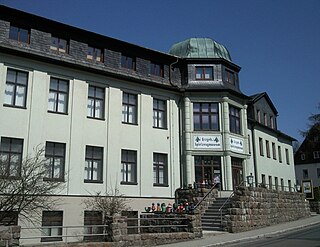
Ore Mountain folk art is a well-known form of highly artistic wood carving from East Germany. It encompasses the diverse forms of expression of the creative work beyond the classical or the modern arts, and in particular the production of figures, sculptures and paintings. In a broader sense, the people's poetry, literature, and the Ore Mountain songs are in itself the folk art. The Ore Mountains claim to be the largest, enclosed folk art area in Germany.
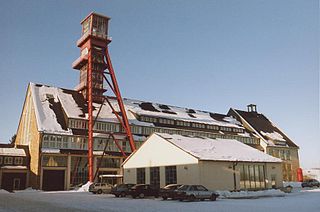
The Ore Mountain Mining Region is an industrial heritage landscape, over 800 years old, in the border region of the Ore Mountains between the German state of Saxony and North Bohemia in the Czech Republic. It is characterised by a plethora of historic, largely original, monuments to technology, as well as numerous individual monuments and collections related to the historic mining industry of the region. On 6 July 2019, the Erzgebirge/Krušnohoří Mining Region was inscribed as a UNESCO World Heritage Site, because of its exceptional testimony to the advancement of mining technology over the past 800 years.

The Miners' Parade is a parade traditionally held in places in Austria and Germany where ore was and is smelted. It was and is a public event held by a community or corporation whose employment is linked to mining and smelting. It is usually known in German as a Bergparade, but also as a Berg- und Hüttenparade. It takes place as one of the highlights of a festival. The Miner's Parade is a special form of procession which is organised to march past important dignitaries or which is organized for such high-ranking individuals.
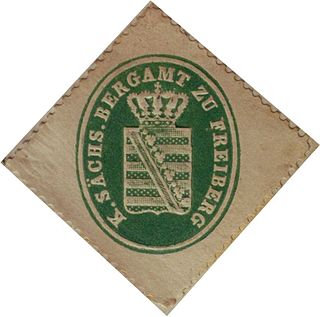
The Saxon Mining Office is the executive authority for mining rights in the German state of Saxony. It is also responsible for all non-metallic mineral resources on the terrain of the former East Germany.

Cuisine in the Ore Mountains was dominated for centuries by the changing economic circumstances of the mining, handicraft and forestry industries, as well as the fortunes of home-based crafts. This is reflected, on the one hand, in the simplicity of cooking ingredients, the art of improvisation and creativity of the Ore Mountain housewife, and, on the other hand, in the very rich cuisine of the manor houses. For example, the lords of Schönberg, who had the closest relations with the court at Dresden, demonstrated their prosperity at the dining table. They also benefited from long-distance trade, thanks to the strategic location of their strongholds in Sayda and Purschenstein, which were situated on the so-called Salt Road. Thus they were able to enjoy the exotic spices and culinary expertise that arrived in coaches and from which their kitchens also benefited.

The Black Triangle is the border region between Germany, Poland and the Czech Republic, long characterized by extremely high levels of pollution. The term was coined in the 1980s. For decades, industrially produced air pollutants, water pollution, acid rain and other effects took an enormous toll on the health of local residents and the surrounding environment.

The Dorothea-Stolln, also known as Himmlisch Heer Fundgrube Dorothea, is a former underground mine in Cunersdorf near Annaberg-Buchholz in Germany. Today, it is a visitor mine with a length of 53 km and a constant temperature of 8 °C. The Upper Saxon word Stolln means an adit, the German word Fundgrube was used to describe the pit that was the first to be awarded on a newly discovered field.
Kurt Kieß was a German politician and party functionary of the Socialist Unity Party (SED).
